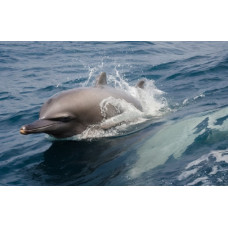Latin name
Sousa plumbea
Other name
Sousa plumbea
Identification
These dolphins have smooth skin, a broad and high forehead, and their eyes are on the side, allowing them to see well underwater and on the surface. The large wedge-shaped teeth on the upper jaw are 31-38 on each side and the lower jaw has 30-37 on each side. This species may look similar to the Indo-Pacific bottlenose dolphins, but they do not have a hump. These dolphins have a characteristic surfacing movement in which they raise their head at an angle of 30 to 45 degrees, sometimes their entire head, before arching their back and sometimes their fins.
Features of fish fins
Indian Ocean humpback dolphins have a fat tubercle on their back, which distinguishes them from S. chinensis, which has a more prominent dorsal fin but no hump.
Fish colouring
Different species of humpback dolphins in the Indian Ocean have different colouring, although juveniles are generally grey, with the top darker than the bottom. They are generally dark grey.
Distribution
The range of these dolphins extends from South Africa to western Indochina, including coastal areas of East Africa, the Middle East and India. The population under study is found in the Menai Bay Sanctuary in the Zanzibar Archipelago of Tanzania. Critical populations have been identified in South East Asia, particularly along the southern coast of China. However, recent studies have also identified critical populations along the coast of the Arabian Peninsula, particularly in the Sultanate of Oman and the United Arab Emirates.
Habitat
The main factor limiting habitat use is water depth, with most individuals remaining in waters less than 20 metres deep. As a result, the habitat range is highly dependent on the specific physiographic characteristics of the coastline. The species has been reported to occur in almost all coastal habitat types, although the preference for and importance of a particular habitat type is highly dependent on geographical location.
Size
They are medium-sized dolphins, ranging from 2 to 2.8 metres (6.6 to 9.2 feet) in length and 150 to 200 kilograms (330 to 440 pounds) in weight.
Behavior
This species does not show much migratory behaviour. They are social and usually live in groups. However, group size is highly variable. Some individuals have been found to be solitary, although the average group consists of about 12 individuals and some of the largest groups observed have exceeded 100 individuals. On rare occasions, interactions (both friendly and aggressive) have been recorded with Indo-Pacific bottlenose dolphin, spinner dolphin and Indo-Pacific finless porpoise.
Food and feeding habits
The Indian Ocean humpback dolphin's diet consists mainly of sciaenid fish, cephalopods and crustaceans.
Reproduction
Females reach sexual maturity at around 9-10 years of age, while males reach sexual maturity at around 12-14 years of age. Fertility peaks between May and June, although they are capable of breeding throughout the year. Pregnancy lasts 10 to 12 months. Observational studies have shown that most females give birth to one calf during each reproductive season, followed by an average calving interval of about 62 months. This long calving interval is partly due to the long rearing period, during which mothers care for their calves for 24 months and the mother-calf relationship can last 3 to 4 years.
Fishing
This species is not commercially important.
Relationship with a person
The Indian Ocean humpback dolphin has an extremely high calf and juvenile mortality rate due to anthropogenic impacts such as pollution, habitat degradation and noise.
| Classification | |
| Phylum | Chordata |
| Class | Mammalia |
| Squad | Artiodactyla |
| Family | Delphinidae |
| Genus | Sousa |
| Species | S. plumbea |
| Features | |
| Conservation status | Endangered |
| Habitat | Pelagic |
| Life span, years | No information |
| Maximum body weight, kg | 200 |
| Maximum length, cm | 280 |
| Sailing speed, m/s | No information |
| Threat to people | Edible |
| Way of eating | Predator |

